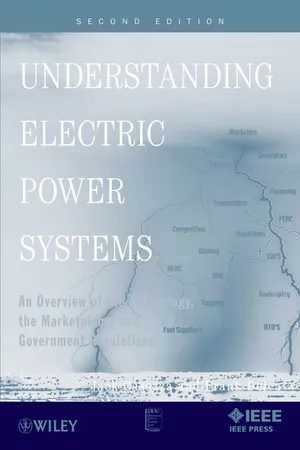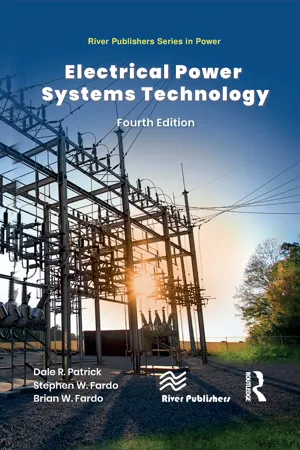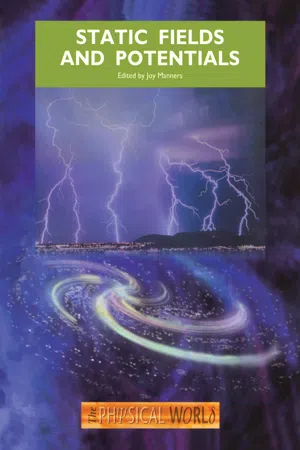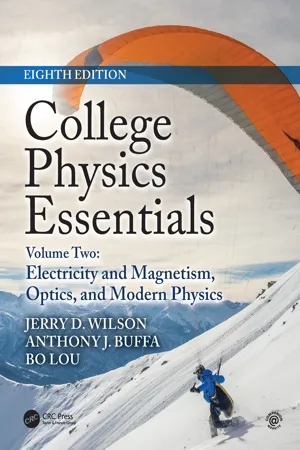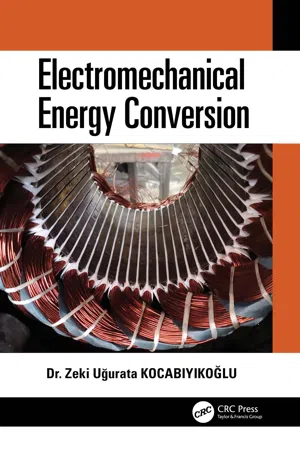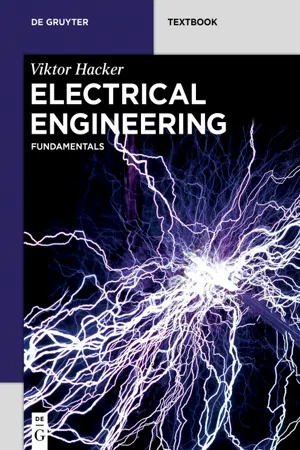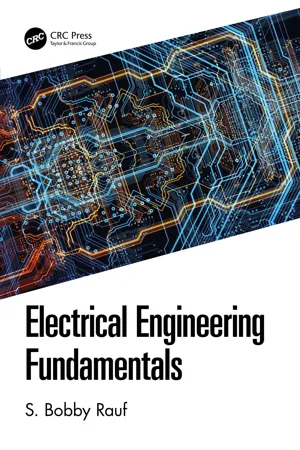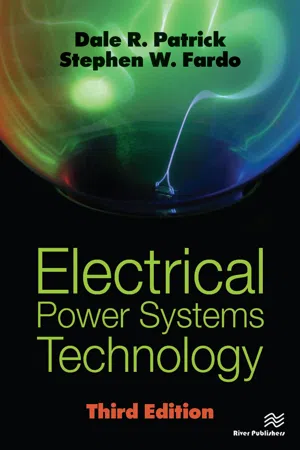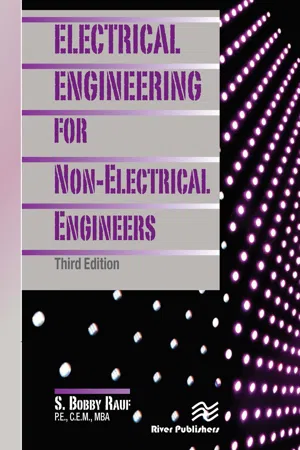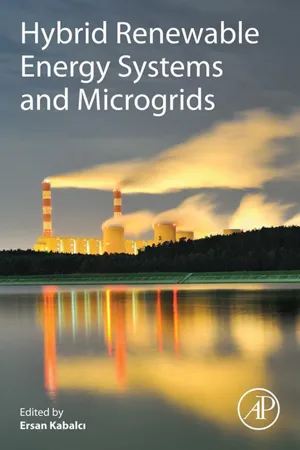Physics
Electrical Power
Electrical power is the rate at which electrical energy is transferred by an electric circuit. It is measured in watts and is the product of voltage and current in a circuit. In practical terms, electrical power is the amount of energy consumed or produced per unit of time.
Written by Perlego with AI-assistance
Related key terms
Related key terms
1 of 4
Related key terms
1 of 3
12 Key excerpts on "Electrical Power"
- eBook - ePub
Understanding Electric Power Systems
An Overview of the Technology, the Marketplace, and Government Regulations
- Frank Delea, Jack Casazza(Authors)
- 2011(Publication Date)
- Wiley-IEEE Press(Publisher)
3 BASIC ELECTRIC POWER CONCEPTSThis chapter describes as simply as possible the applicable physical laws and concepts needed to understand the physical operation of an electric power system. In Chapter 18, the commercial operation of a system is covered. An attempt has been made to present the material in a nontechnical (i.e., with as few equations as possible) manner.It is important to remember that the operation of an electric power system is governed and described by the laws of physics, which are unchanging, whereas the commercial operations are subject to manmade rules that are subject to modification and change. There is an interrelationship between the two in that the rules established for commercial operations must recognize and respect the physical laws by which the power system operates and the commercial rules often determine the design and operation of the system.A note on terminology is warranted. As the electric utility industry developed, an associated jargon evolved, some of which you have already been exposed to in Chapter 2. In some instances, the words used are simply contractions of longer terms; for example, the use of “amps” in place of “amperes” to describe electrical current. In other instances, a variety of terms are used to describe a single concept; for example, the use of the terms “grid,” “the interconnection,” and “the bulk power system” to describe the totality of all the electric transmission.323.1 ELECTRIC ENERGYEnergy is defined as “the capacity for doing work.” Electricity is but one of many forms of energy. Other familiar forms of, or descriptions of, energy are thermal or heat, light, mechanical, nuclear, and so on. Energy is also described as kinetic—that energy associated with a moving body—and potential energy—that energy associated with an object’s position.For centuries mankind has used energy in its various forms to enhance its standard of living. In many cases, ways have been devised to change energy from one form to another to increase its usefulness. An example, as old as mankind, is the burning of a fuel to produce heat and light. - eBook - ePub
- Dale R. Patrick, Stephen W. Fardo, Brian W. Fardo(Authors)
- 2022(Publication Date)
- River Publishers(Publisher)
which the work is done. For instance, Electrical Power is the rate at which work is done as electrical current flows through a wire. Mechanical power is the rate at which work is done as an object is moved against opposition over a certain distance. Power is either the rate of production of energy or the rate of use of energy. The watt is the unit of measurement of power.Sample Problem: Power
Power is the time rate of doing work, which is expressed as follows:p =W t,where P = power in watts, W = work done in joules, and t = time taken to do the work in seconds.Given: An electric motor is used to move an object along a conveyance or line. The object has a mass of 150 kg and is moved 28 m in 8 s. Find: The power developed by the motor in watts and horsepower units. Solution:F o r c e( F )= 9.8 × m a s s= 9.8 × 150 k gF = 1470 n e w t o n sW o r k( W )= F × d= 1470 × 28 mW = 41 , 160 j o u l e sP o w e r( P )= W / t= 41 , 160 / 8P = 5145 w a t t sH o r s e p o w e r =Psin c e7461 h o r s e p o w e r = 746 Wh p = 5145 / 746 = 6.9 h pElectrical Power System
A block diagram of the Electrical Power systems model used in this textbook is shown in Figure 2-4 - eBook - ePub
- Joy Manners(Author)
- 2020(Publication Date)
- CRC Press(Publisher)
V in volts, then to satisfy the above equation the unit of potential energy must be the joule. Power can be defined as the rate at which work is done, or energy is transferred, and the unit of power, the watt, is equal to one joule per second.In the electrical case, the electrostatic potential energy is dissipated as heat and the rate at which this occurs is given bypower =loss of potential energy time interval.Substituting from Equation 3.14 and letting the time interval be ∆t, we getpower =.Δ q × VΔ tBut, the rate of transfer of charge, ∆q/∆t, is simply the average current, and in the limit of small ∆t this becomes dq/dt, the instantaneous current, i. So, in electric circuits,power = i V .(3.15)If i is measured in amps and V in volts, then the power calculated from Equation 3.15 will be in watts.If a current i is passed through a resistor with resistance R, we can use Ohm's law to find a way of expressing Equation 3.15 for the electric power dissipated in the resistor in terms of i and R. A simple substitution is all that is needed. Equation 3.15 tells us that power = iV. But V = iR and so, substituting for V,power = i V = i × i R =(3.16)i 2R .We can also substitute for i in Equation 3.15, to obtain the power in terms of V and R:power = i V =(3.17)V R× V =.V 2RThe cost of energyElectricity companies in the United Kingdom charge domestic customers for the amount of electrical energy that they use. This is just the product of the power and the time. They do not charge ‘per joule’: instead, their bills are written in terms of kilowatt hours (kWh):1 kW h = 1 kilowatt × 1 hour=(×)10 3watts(3600 seconds)= 3.6 ×10 6J .Although electricity bills may always seem too large, in fact, when compared with the cost of human labour, electricity is still extremely cheap. An adult human requires of the order 10 MJ of energy per day to ‘tick over’. This energy is expended keeping one's metabolism in order and performing light manual work. A worker who shifts, say, 1000 shovel loads of soil in a day's work might need as much energy again. But we see from above that 10MJ of electrical energy corresponds to roughly 3 kW h and would cost only about 21 pence. - eBook - ePub
- Steven W. Blume(Author)
- 2011(Publication Date)
- Wiley-IEEE Press(Publisher)
Voltage by itself does not do any real work. Current by itself does not do any real work. However, voltage and current together can produce real work. The product of voltage × current is power. Power is used to produce real work. The basic unit (measurement) of power is the watt. Electrical Power can be used to create heat, spin motors, light lamps, and so on. Power is the product of voltage × current; therefore, power equals zero if either voltage or current is zero.EnergyElectrical energy is the product of Electrical Power × time. The amount of time a load is on (i.e., current is flowing) × the amount of power used by the load (watts) is energy. The common measurement for electrical energy is watt-hours. The more common units of electrical energy in power systems are kilowatt-hours (kWh, meaning 1000 watt-hours) for residential applications and megawatt-hours (MWh, meaning 1,000,000 watt-hours) for large industrial or power company applications.ImpedanceThe concept of circuit impedance is a little challenging to comprehend. Impedance is the term used to describe the total opposition to current flowing in AC circuits. It is composed of resistors, capacitors, and inductors. Electrical impedance extends the concept of resistance to AC circuits. When the circuit is DC only, there is no distinction between impedance and resistance. When the circuit is AC, capacitors and inductors have different resistances for different frequencies. Therefore, the AC impedance of a circuit varies depending on frequency.Impedance of a circuit is represented by the symbol “Z.” Impedance is the total opposition to current flow in a circuit that is made up of resistance, inductance, and capacitance. The impedance of an AC circuit is measured in ohms. The impedance of a DC circuit (i.e., resistance circuit) is also measured in ohms.ResistanceThe electrical resistance of an element measures its opposition to current flow. It is similar to friction in mechanical movement. The resistance of a body stays the same whether the current flowing is AC or DC. In other words, a resistor maintains its value of resistance over all frequencies. It is measured in ohms.InductanceThere are two common forms of inductance: self-inductance and mutual inductance. Self-inductance is the property of an electrical circuit that causes voltage to be generated proportional to the rate of change of current in a circuit. Mutual inductance describes the voltage induced in an electrical circuit by the rate of change of the electrical current flowing in another circuit. This term becomes prevalent when copper communications cables parallel HV power cables. - eBook - ePub
- Adrian Waygood(Author)
- 2018(Publication Date)
- Routledge(Publisher)
work ’ is being done. For example, when an electric motor converts electrical energy into kinetic energy, the motor is doing work.Energy is transferred between objects whenever those objects are at different temperatures. We call this process ‘heat transfer ’. You will recall that the term ‘heat’ describes ‘the transfer of energy from a warmer body to a cooler body’ .Both work and heat are expressed in joules.Work is defined as ‘the conversion of energy from one form into another’ .Heat is defined as ‘the transfer of energy from a body at a higher temperature to one at a lower temperature’ .Finally, we should also remind ourselves that ‘power ’ is defined as ‘the rate of doing work’ or ‘the rate of heat transfer’, expressed in watts.Power is defined as ‘the rate of doing work' , or 'the rate of heat transfer’ .Behaviour of energy in a.c. circuits
Behaviour of energy in purely resistive circuits
Whenever an electric current overcomes the resistance of a conductor, it does work on that conductor (W = I 2 Rt) , causing its internal energy (the vibration of its atoms) to increase. An increase in internal energy is always accompanied by an increase in temperature and, if the temperature of the conductor exceeds that of its surroundings, then energy will be transferred away from the conductor into its surroundings through heat transfer .As you may recall, from the chapter on resistance the consequence of resistance is heat.Heat transfer away from a conductor is completely irreversible . That is, you cannot transfer that energy back into the conductor and send it as electrical energy back to the supply. Once it’s gone, it’s gone for good!The rate of heat transfer away from a conductor to its surroundings is termed ‘power’, and is expressed in watts. For reasons that will shortly become clear, in a purely resistive circuit, it is traditional to refer to this as either ‘true power ’, ‘real power ’ or ‘active power ’ (symbol: P - eBook - ePub
College Physics Essentials, Eighth Edition
Electricity and Magnetism, Optics, Modern Physics (Volume Two)
- Jerry D. Wilson, Anthony J. Buffa, Bo Lou(Authors)
- 2019(Publication Date)
- CRC Press(Publisher)
However, superconductivity does have the potential for important everyday applications, if materials can be found that are superconducting near room temperature. In the absence of resistance, high currents and very high magnetic fields are possible (Chapter 19). Used in motors or engines, superconducting electromagnets would be more efficient, providing more power for the same energy input. Superconductors might also be used as electrical transmission lines with no resistive losses. Some researchers envision superfast superconducting computer memories. The absence of electrical resistance opens almost endless possibilities. You are likely to hear much more about superconductor applications in the future as new materials are developed.17.4 Electric PowerWhen a sustained current exists in a circuit, the electrons are given energy by the voltage source, such as a battery. As these charge carriers pass through circuit components, they collide with the atoms of the material, (i.e., they encounter resistance) and lose energy. The energy transferred in the collisions can result in an increase in temperature. In this way, electrical energy can be transformed, at least partially, into thermal energy.However, electric energy can also be converted into other forms of energy such as light (as in lightbulbs) and mechanical motion (as in electric motors). According to conservation of energy, whatever forms the energy may take, the total energy delivered to the charge carriers by the battery must be completely transferred to the circuit elements (neglecting losses in the wires). That is, on return to the power supply or battery, the charge carriers must lose the energy gained from the source, and the process is then repeated.The energy gained by an amount of charge Δ q from a voltage source (voltage Δ V ) is the same as the work done on it, or W = Δ q ⋅ Δ V . Over a time interval of Δ t, the rate at which energy is delivered (or work is done) may not be constant. Thus the average rate of energy delivery, or the average electric power is. In the special case when the current and voltage are constant (as with a battery), then the average power is constant. For steady (dc) currents, the current is I = Δ q /Δ tP ¯= ( W / Δ t ) = ( Δ q ⋅ Δ V ) / Δ t ) - eBook - ePub
- Zeki Uğurata Kocabiyikoğlu(Author)
- 2020(Publication Date)
- CRC Press(Publisher)
1 Basic Principles of Energy, Power and Electrical Power Systems1.1 Physical Foundations of Energy and Power
1.1.1 Energy
Here, we shall provide a reminder about- what energy is
- how it changes
- how electrical energy is obtained.
Energy is defined as the “capacity of a system to do work”. The most common unit used for energy is joule, abbreviated J. Electric utilities bill the energy in kilowatt hours (kWh). A kWh represents “one kW being used for one hour”, and it equals 3.6 MJ of energy. Energy can exist in many forms like heat, light, sound, mechanical, and electrical. It cannot be consumed but can be converted from one form to another. This is the law of “conservation of energy” described in the “first law of thermodynamics”. Whenever energy changes from one form to another, some of it is lost as heat. This is because energy transformations are not energywise reversible. Heat is a disorderly form of energy. On the other hand, electrical energy, kinetic energy, and potential energy are orderly forms of energy.Orderly forms of energy can easily be converted to heat. For example, electrical energy can be easily converted to heat by making a current flow in a resistor or by dropping a stone from a hill onto a hard surface and converting partially its kinetic energy to heat. On the other hand, transforming heat into electrical energy is much more difficult.The second law of thermodynamics says that “nature has a tendency towards disordered forms of energy”. This means that converting heat to electricity will not be as efficient as converting electricity to heat. About 60% of the heat energy input to power plants is lost as waste. Energy can be in the form of “kinetic energy” as in the case of a truck travelling down the hill, or it can be in the form of “potential energy” as in the case of a skier standing at the top of a hill (Figure 1.1 - eBook - ePub
Electrical Engineering
Fundamentals
- Viktor Hacker, Christof Sumereder(Authors)
- 2020(Publication Date)
- De Gruyter Oldenbourg(Publisher)
B have to be fulfilled.Figure 1.17: Superconducting surface.1.11 Energy and Electrical Power
Electrical energy is provided by the combination of electric current and electric potential in an electrical circuit. The mechanical workW = ∫is comparable to electrical work done on a charged particle by an electric field.F ⃗⋅ ds ⃗If the force (F ) is used to lift an object by the distance (s), mechanical work is carried out. The object now has higher energy content by that amount (potential energy). This energy can perform work by e.g. letting the object drop.Electric energy the following applies:W = Q ⋅ V = V ⋅ I ⋅ tV Voltage in VI Current in At Time in sQ Electric charge in AsW Electrical work/energy in WsThe electric charge represents the product of current I multiplied by time (Q = I ⋅ t ). Therefore, the following applies:W =⋅ t = P ⋅ tPV ⋅ I⏟P Power in WThe work performed per time unit is called power P.P =W tWith direct current, the electric power P that is transformed in an electric load is the result of the voltage V multiplied by the current I :P = V ⋅ IPower is one of the most important parameters for electrical machines and devices. By insertion of the Ohm’s law, the equation can be transformed to:P = Wor also:Power hyperbola
All V-I pairs of values that lead to the same power, e.g.P = 2 W - eBook - ePub
- S. Bobby Rauf(Author)
- 2020(Publication Date)
- CRC Press(Publisher)
1 Fundamental Electrical Engineering Concepts and PrinciplesIntroduction
In this first chapter of the Electrical Engineering Fundamentals text, we will explore fundamental electrical engineering terms, concepts, principles, and analytical techniques and impart knowledge that is considered elemental in the discipline of electrical engineering. Readers who invest time and effort in studying this text are likely to do so for the key purpose of gaining an introduction into the field of electricity. In this chapter, we will lay the foundations in the electrical engineering realm by covering basic electrical engineering terms, concepts, and principles, without the understanding of which, discussion and study of terms that bear important practical significance, such as power factor, real power, reactive power, apparent power, and load factor, would be untenable.Most of the material in this chapter pertains to DC, or direct current, electricity. However, some entities discussed in this chapter such as capacitive reactance, inductive reactance, and impedance are fundamentally entrenched in the AC, alternating current, realm.This text affirms that electrical engineering is rooted in the field of physics and chemistry. Physics, chemistry, and electrical engineering, as most other subject matters in science, depend on empirical proof of principles and theories. Empirical analysis and verification require tools and instruments for measurement of various parameters and entities. Hence, after gaining a better understanding of the basic electrical concepts, we will conclude this chapter with an introduction to three of the most common and basic electrical instruments, namely, multi-meter, clamp-on ammeter, and a scope meter or oscilloscope.Voltage or EMF (Electromotive Force)
Voltage can be defined as a “force” that moves or pushes electrically charged particles like electrons, holes, negatively charged ions, or positively charged ions by forming an electric field. The term “electromotive” force stems from the early recognition of electrical current as something that consisted, strictly, of the movement of “electrons.” Nowadays, however, with the more recent breakthroughs in the renewable and non-traditional Electrical Power generating methods and systems like microbial fuel cells and hydrocarbon fuel cells, Electrical Power is being harnessed, more and more, in the form of charged particles that may not be electrons. In batteries, such as those used in automobiles, as we will see in the batteries chapter, the flow of current driven by voltage potential difference consists not only of negatively charged electrons, e− , but also types of ions, including H+ and HSO4 − ions.1 - Dale R. Patrick, Stephen W. Fardo(Authors)
- 2020(Publication Date)
- River Publishers(Publisher)
Unit V ), is probably the most complex of all the parts of the Electrical Power system. There are almost unlimited types of devices, circuits, and equipment used to control Electrical Power systems.Figure 2-4. Electrical Power Systems ModelEach of the blocks shown in Figure 2-4 represents one important part of the Electrical Power system. Thus, we should be concerned with each one as part of the Electrical Power system, rather than in isolation. In this way, we can develop a more complete understanding of how Electrical Power systems operate. This type of understanding is needed to help us solve problems that are related to Electrical Power. We cannot consider only the production aspect of Electrical Power systems. We must understand and consider all parts of the system.TYPES OF ELECTRICAL CIRCUITS
There are several basic fundamentals of Electrical Power systems. Therefore, the basics must be understood before attempting an in-depth study of Electrical Power systems. The types of electrical circuits associated with Electrical Power production or power conversion systems are (1) resistive, (2) inductive, and (3) capacitive. Most systems have some combination of each of these three circuit types. These circuit elements are also called loads. A load is a part of a circuit that converts one type of energy into another type. A resistive load converts electrical energy into heat energy.In our discussions of electrical circuits, we will primarily consider alternating current (AC) systems at this time, as the vast majority of the Electrical Power that is produced is alternating current. Direct current (DC) systems will be discussed in greater detail in Chapter 7 .POWER IN DC ELECTRICAL CIRCUITS
In terms of voltage and current, power (P) in watts (W) is equal to voltage (in volts) multiplied by current (in amperes). The formula is P = V × I. For example, a 120-V electrical outlet with 4 A of current flowing from it has a power value ofP = V × I = 120 V × 4 A = 480 W .The unit of Electrical Power is the watt. In the example, 480 W of power are converted by the load portion of the circuit. Another way to find power is:- S. Bobby Rauf(Author)
- 2021(Publication Date)
- River Publishers(Publisher)
Chapter 1 Electrical Engineering Basics and Direct CurrentIntroduction
In this chapter, we will explore the basics of electrical engineering terms, concepts, principles, and analytical techniques. Many readers who embark on investing time and effort in studying this text are likely to do so for the key purpose of gaining an introduction into the field of electricity. Many others, on the other hand, might be interested in refurbishing prior knowledge of electrical engineering terms, concepts, principles, and basic analytical techniques. Regardless of whether you belong to one of these two groups —or are simply in pursuit of electrical engineering at the intermediate or associate degree level — in this chapter we will lay the foundations in the electrical engineering realm by covering basic electrical engineering terms, concepts, and principles, without the understanding of which, discussion and study of terms that bear important practical significance, such as power factor, real power, reactive power, apparent power, load factor, etc. would not be feasible.Most of the material in this chapter pertains to DC, or Direct Current, electricity. However, some entities we will discuss in this chapter, such as capacitive reactance, inductive reactance, and impedance are fundamentally premised in the AC, Alternating Current, realm.Electrical engineering is largely rooted in the field of physics. Physics, and electrical engineering, as most other fields in science, depend on empirical proof of principles and theories. Empirical analysis and verification require measurement tools or instrumentation. So, after gaining a better understanding of the basic electrical concepts, we will conclude this chapter with an introduction to two of the most common and basic electrical instruments, i.e., multi-meter and clamp-on ammeter.- eBook - ePub
- Ersan Kabalci(Author)
- 2020(Publication Date)
- Academic Press(Publisher)
Generally, it is found difficult to grasp the concepts of these electrical quantities by most students of science and engineering because these are entirely different from the normal things that we have around us. Electrical phenomena have a definite mysteriousness that we cannot directly derive from our direct experience and need to gain the knowledge from the powerful fundamental force of nature they represent. Electric charge is also considered as one of the basic physical quantities in addition to mass, distance, time, and temperature for measurement. The combination of these five quantities is used to represent several physical units. However, the electric charge is realized as an entirely isolated quantity from the other four. It is so because “charge” is hard to perceive as a physical phenomenon, whereas other physical quantities such as the size of an object can be imagined and sensed by its weight. Moreover, the electrical process is also involved in our bodies, but generally, we hesitate to apply the concepts of electrical quantities or forces. For example, these concepts can be practiced from our cell metabolism to neural impulses. Electric shock is usually considered as a recognizable example of electricity. An exceptional feeling is realized after the shock that sends such a strong wave of nervous impulses through our bodies. There are different other effects of electricity on our bodies like hair that rebelliously stands on end, a zap from a doorknob, and static cling in the laundry. Unfortunately, these types of effects are avoided to analyze in terms of electric power, where we can practically realize the effects of electricity, such as turning on a light bulb or rotating a motor. Every important phenomenon occurs like a ghost within pieces of metal
Index pages curate the most relevant extracts from our library of academic textbooks. They’ve been created using an in-house natural language model (NLM), each adding context and meaning to key research topics.
Explore more topic indexes
Explore more topic indexes
1 of 6
Explore more topic indexes
1 of 4
